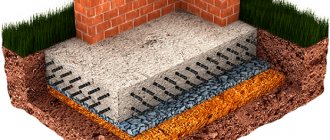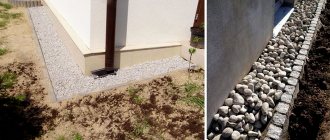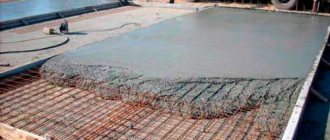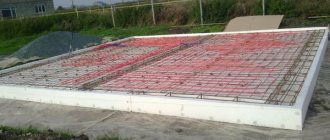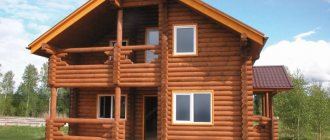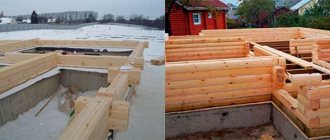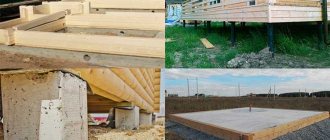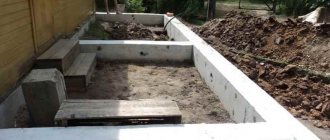Types of pillows
How to make a foundation cushion for a certain type of soil?
There are three types of pillows: sand, crushed stone and combined gravel-sand.
The sand cushion can be installed under a strip foundation. The sand should be coarse-grained or medium-grained.
On weak-bearing soil, a sand-crushed stone cushion is installed. The ratio of such a tandem should be: sand - forty percent, crushed stone - sixty percent. The crushed stone cushion does not shrink after it has been laid and can easily withstand the weight of a wooden house, even without reinforced compaction. If you plan to build heavier buildings, then compacting such a cushion is mandatory.
Using crushed stone to make a pillow
It is very difficult to imagine at least one construction site that could do without crushed stone. This building material is very difficult to replace with anything else. It is obtained by crushing mountain stones, boulders, and gravel.
Crushed stone comes in different types:
- Gravel - has high strength, low background radiation. It is obtained by sifting rocks and crushing stones using specialized equipment. It has a low cost.
- Granite is a high-strength type, used mainly in civil engineering, easy to process and can withstand heavy loads. It is obtained by processing natural granite, which is mined by blasting rocks. It is ideal for the production of reinforced concrete blocks and pouring foundations. But it has a minor drawback: it accumulates radiation. Of course, the accumulations are not significant and are not at all dangerous to human health.
- Limestone is the cheapest type of crushed stone. It has lower quality characteristics compared to the two previous types. It is obtained from limestone rocks and is resistant to low temperatures.
What crushed stone is suitable for creating a pillow?
The most common type of crushed stone for pouring under the foundation, having a fraction of twenty to forty millimeters. It is included in the first category of radioactivity and is absolutely safe for human health. Strength – M1200. It has frost-resistant characteristics, which is very convenient for compacting pillows from it.
If we consider a cheap option, then it can include secondary crushed stone, which is obtained by crushing old concrete.
In order for the building to stand for many years, and the foundation not to be modified, crushed granite stone is used. This is the most expensive option. But thanks to its characteristics, it will withstand any construction. Typically, granite crushed stone is combined with other building materials, most often with sand.
How to make a pillow from crushed stone
A crushed stone cushion for the foundation is used in the construction of large country houses and cottages, and it does not matter what material the building is built from.
Before starting construction work, the base should be covered with finer material. As it, you can use river sand of medium or large size. It does not contain organic substances that can decompose and rot over time. Therefore, it can be used without additional processing. The sand mound should be from ten to fifteen centimeters. After which it needs careful uniform distribution and compaction. If this requirement is not met, the surface may turn out to be uneven, and it is unlikely that this defect will be corrected later.
Only after creating a preliminary layer can crushed stone be poured, the layer of which should vary from twenty to twenty-five centimeters. It, like the sand layer, needs to be well leveled and compacted using a vibrating plate or tamping roller.
If you don’t have such devices in your arsenal, you can make such a tool yourself. To do this you need a log about one meter in size. Two handles are screwed to it, after which the end part of the log is drawn across the entire area of the future foundation. This process is easy to use, you just need to throw a log and when it falls, the sand and crushed stone flooring will be compacted.
This layer will be the beginning of the foundation.
Next, it is necessary to continue work on creating the foundation. The crushed stone layer is covered with mortar. It can be sand-cement, lime-cement, cement-clay. The foundation is laid on a ready-made crushed stone layer. The height is usually chosen from fifteen to twenty centimeters from ground level. The masonry, in this case, can consist of brick or rubble stone. The masonry is reinforced with steel wire. This action is performed to enhance the reliability and strength of the foundation.
Sometimes a pillow is created only from crushed stone. But this only happens if the soil on which the building will stand is sandy. The technology is identical to laying a sand-crushed stone cushion. In addition, the crushed stone base fits perfectly under the foundation, in this case the durability of the foundation is ensured for many years. Crushed stone can easily become a substitute for sand, and its use is indispensable on problematic soils where pouring a foundation is very difficult.
Basics of concrete pouring technology for foundations
The steps for preparing a concrete pad, as well as the base, include the following:
- installation of formwork (flat boards) limiting the shape of the concrete mixture. There should be no gaps in the formwork below through which concrete can leak. Otherwise, the formwork will rise, which will lead to a change in the shape and size of the cast slab;
- preparation of concrete solution produced in a concrete mixer. It is impossible to prepare the mortar manually, as is common when laying walls, for large volumes of work. The reason is the deterioration in quality due to uneven manual mixing, as well as the lack of solidity of the future slab;
- pouring concrete into forms limited by formwork. It is recommended to cover the resulting layer with a polymer film to prevent rapid hardening.
Setting of concrete occurs within 2 weeks. During the first week, it is advisable to moisten the hardening solution with water - this way you can avoid drying out and cracking.
Calculation of the amount of crushed stone and sand for the pillow
But how much crushed stone is needed for a pillow? Typically, a first layer of sand of both medium and coarse grains is laid under the foundation. The density of crushed stone should be from 2.0 – 2.7 g/cm³. There is no need to carry out preliminary work on leveling the trench, since the pad itself is part of the leveling layer. The thickness of the pillow should vary between ten and fifty centimeters, but may vary due to the load-bearing characteristics of the base. The pillow is poured in layers, each layer should be ten centimeters and very well moistened with water. Then compaction is carried out using a vibrating rammer.
The sand cushion is calculated using the formula. The first step is to calculate the depth of the foundation. But if the soil is problematic, then it is worth considering replacing it with sand. Next, the width of the fundamental surface is calculated.
There is a simpler way to calculate: To do this, measure the foundation. The width and length of the trench are multiplied. The result is once again multiplied by the total thickness.
You can make a pillow out of crushed stone with your own hands in other ways.
Use of crushed stone in the construction of foundations for buildings
The foundation consists of several parts (concrete base, cushion, foundation, blind area), the question of what fraction is needed for the foundation during its construction must be solved in a complex, since different types of materials and fraction sizes are used for each part:
- Crushed stone preparation for the foundation, carried out to preserve liquid, is the 1st layer for the foundation. The 40 x 70 fraction is filled with bitumen or a layer of concrete (10 cm) is laid out, for which crushed stone measuring 10 x 20 mm is taken.
- Use a bulk foundation made of medium-grained crushed stone with a size of 20 x 40 to lay the cushion.
- Concrete grade M 600 is used to ensure that the crushed stone base for the foundation is strong. Limestone crushed stone is not used for pillows due to its strong shrinkage.
- At the time of preparing the solution, it may be difficult to determine what fraction of crushed stone is needed for the foundation. For it, a size of 5 -10 mm, 10 -20 mm and 20 - 40 mm is selected.
- For the blind area, it is important to create drainage. Concrete crushed stone or limestone is laid in it. The fraction used is fine-grained.
The choice of crushed stone can be made taking into account all the features of the foundation being built. It is important to take into account the characteristics of the soil and the dimensions of the building when calculating the permissible pressure on the foundation. For residential buildings with several floors, it is preferable to build the base with crushed granite. Lightweight buildings will withstand limestone and gravel.
Features of making a pillow for the foundation
- When pouring wet sand into a trench, the compaction process can be eliminated; compaction will occur by itself. If the sand is dry, then it must be thoroughly moistened and compacted. To do this, the sand embankment must be made proportionally and compacted alternately. To check the quality of the placed pillow, you can walk on it. If no traces of the sole remain on it, then the job is done well.
- When making a pillow, it is necessary to take into account how much the groundwater rises in the off-season. If it rises above normal, then the thickness of the sand and crushed stone layer needs to be increased.
- When compacting the pillow, you should pay attention to its evenness and horizontality. It is possible to control the process using a building level.
- Some construction experts recommend laying geotextiles or roofing felt at the bottom of the trench. This trick helps avoid mixing soil with sand.
- A big factor in choosing a cushion is the type of foundation that will be installed.
Related publications:
- Sand cushion for strip foundation
- Sand and gravel cushion for the foundation
- Concrete pad under the foundation: types, necessity and installation
- Crushed stone fraction for the foundation: types and features
Click to cancel reply.
What brand of crushed stone is needed for the foundation
When choosing a brand of crushed stone, the buyer is faced with a difficulty, since they all have certain performance characteristics. The building material is used for equipping sites, access roads, country paths, and swimming pools. Among the variety, choosing crushed stone for the foundation that has the qualities of strength and longevity is not easy.
Main characteristics and classification of crushed stone
Having begun the construction of the foundation of the house, the owner decides what crushed stone is needed for the foundation. It is advisable to be guided by regulatory documents that give the classification and technical characteristics of crushed stone. SNIP (building codes and regulations) contains information about permissible standards for impurities. Popularly, these norms and requirements are set out in the article.
The material has many options that differ in performance characteristics. Crushed stone must be used taking them into account. Building materials are classified according to the following parameters:
- material;
- cleanliness;
- factionalism;
- flakiness;
- strength;
- frost resistance.
When determining which fraction of crushed stone is best for the foundation of a house, it is necessary to take these parameters into account.
About the meaning of purity
The purity of materials for a crushed stone foundation is one of the parameters of its high quality. foreign inclusions get into it. When choosing a material, you need to familiarize yourself with the product quality certificate, which shows the percentage of inclusions. crushed stone should not have impurities (more than the norm allowed by the standard) that provoke corrosion. It is unacceptable for inclusions harmful to its strength to enter the solution:
- phosphorites, chlorites, apatites;
- shale, coal, acids;
- asbestos fibers.
the presence of inclusions is allowed in the standard volume. they cannot occupy more than 0.1 to 15%. above this indicator they are destroyed by a concrete monolith.
what you need to know about the flakiness of crushed stone
this parameter gives an idea of the relationship between stones of different shapes. There are 4 main varieties:
- cubic grains;
- acute-angled;
- wedge-shaped;
- flaky.
flakiness indicates the presence of lamellar and needle-like fragments. the higher the percentage of flakiness, the lower the quality of the crushed stone. Cuboid stones are considered the most durable. concrete made from them has a uniform high density. When constructing the foundation of housing, granite stone is used. According to the flakiness, crushed stone has the following varieties:
- The first of them consists of cube-shaped grains used for the base of buildings.
- the second group, which contains 10-15% of other types of material, is also suitable for these purposes.
Group 3 - limestone rocks, including 15-50% substandard crushed stone. stones have weak adhesion, so they are not suitable for constructing the foundation of buildings.
acceptable options for using them under a cushion and for a foundation made of crushed stone, the flakiness fraction of which is 25-35% of inferior material.
stones belonging to groups 1 and 2 are most suitable for making the base of buildings.
The use of substandard crushed stone for the foundation of buildings is not recommended. Over time, it will begin to crumble, delaminate and lose reliability.
about the influence of frost resistance
The measurement of frost resistance is the number of cycles of complete freezing and thawing of the stone without loss of technical qualities. it is designated by the letter “f” (from English “frost” or frost). crushed stone made from various materials has the following frost resistance parameters:
- from limestone – f25÷f100;
- concrete – f50÷f75;
- slag – f75÷f200;
- gravel – f200÷f300;
- granite – f300÷f400.
crushed stone is used for the foundation of houses, the frost resistance coefficient of which is f250-300.
crushed stone strength grades
Varieties of material have a strength grade, established by determining the coefficient of high loads, abrasion, pressure, crushing:
- m200 - crushed stone of very low strength;
- m300 and m600 - low strength;
- m600 and m800 - medium strength;
- m800 and m1200 - optimal strength;
- m1200 and m1400 - high strength.
The pillow is made on the basis of the M800 brand. It is recommended to pour the foundation with M1200 grade of stone.
about the factionality of crushed stone
The stones are fractionated during sifting. Before deciding which fraction of crushed stone is needed for the foundation of a house, it is advisable to familiarize yourself with its types:
- European standard material, calculated in millimeters, has fractions: 3÷8, 5÷10, 10÷15, 15÷20, 20÷40, 40÷80.
- crushed stone with non-standard shapes, ordered by the consumer.
for the construction of the base of buildings, the optimal fractions will be: 5 -10 mm, 10 -20 mm and 20-40 mm.
material for the production of crushed stone
The material is made from various materials, then sifted and sorted. The resulting dimensions (fractions) of the stone are used to build the foundation. Each type of crushed stone is based on material. It is produced:
- made of rock;
- waste from its processing;
- industrial waste;
- from used concrete.
Features of crushed granite
For the foundation of a residential building, this type of material is the best option. This is an elastic, strong and durable material. The mineral contains quartz and mica. It has a granular structure. Due to the presence of feldspar in the mineral, which gives it different shades of color, crushed stone casts all the colors of the rainbow.
Different colors and grain sizes are considered a distinctive feature of crushed granite.
crushed gravel
Along with crushed stone obtained by processing boulders, this category includes gravel deposits from the bottom of seas and rivers. Consumers do not see the difference between them and find it difficult to understand the problem of which is better, gravel or crushed stone. Natural gravel resembles granite, except it is less durable. The foundation for housing is built from it. The stone has no radioactivity and is cheaper.
Limestone crushed stone
This is an inexpensive building material containing calcite. Crushed limestone is not suitable for housing foundations. It is also not recommended for a pillow because the material is fragile, susceptible to erosion and quickly destroyed. It is used only for the construction of foundations for light buildings that do not exert strong pressure on it.
Crushed stone from slag
The material is widely used in casting reinforced concrete structures, but building foundations for housing from it is strictly prohibited due to its chemical composition:
- Slag reduces the strength of concrete.
- It is dangerous for fittings.
Metallurgical waste is characterized by increased radiation. They are harmful to human health.
Crushed concrete
The cost of the stone is almost two times lower than that of granite, and the quality of the building material is inferior to natural stone. It is used:
- for trails;
- filling paths;
- reinforced concrete structures.
Concrete crushed stone is suitable for making cushions and foundations for outbuildings. Before using recycled building material, it is necessary to check the accompanying papers in order to establish its previous use.
Recycled materials of unknown origin are not recommended for the construction of the foundation for new housing.
The importance of crushed stone fractions for the quality of the foundation
The quality of the foundation depends on the use of different fractions of crushed stone. They perform a number of functions in concrete:
- Makes the composition more dense.
- Provide minimal shrinkage.
The quality of concrete is achieved by reducing the amount of empty space, which is possible with the correct ratio of materials included in the concrete solution. Its optimal composition contains crushed stone of different sizes. This helps fill the voids with smaller grains.
About the main criteria for choosing crushed stone
The choice of building material for the foundation is based on many parameters. But there are a number of circumstances that have to be taken into account during construction:
- The main selection criterion is the budget, which allows you to purchase the best type of material that will ensure the quality and durability of the house.
- A replacement for granite stone will be gravel, the cost of which is lower, and its quality allows it to be used for building a foundation.
- The material is selected taking into account the mixing of the solution (manual or mechanized).
- One-story buildings are built on a base with gravel material. Multi-storey buildings need a solid granite foundation. Light-weight buildings will withstand limestone.
- The grain fraction is selected depending on the size of the reinforcement.
If doubt arises whether it is possible to pour a foundation without crushed stone, then it is clear that the foundation of a house without stone will be short-lived and dangerous. The two strongest types of gravel and granite are suitable for the base of buildings.
The building material should not have a radioactive background and be environmentally friendly, but some rocks contain radioactive substances. Based on their presence, the material is divided into 3 classes:
- 370 Bq/kg – for housing.
- Up to 740 Bq/kg – roads in populated areas.
- Over 740 Bq/kg d – traces.
When choosing a material, check the presence of radiation according to the product certificate, since there are cases of overestimation in practice.
About the optimal proportions of concrete for the foundation
The strength of the foundation depends on the method of preparing the solution and its composition. This is confirmed by a table reflecting the ratio required for a certain brand of concrete. The M100 and M150 grades have less strength. The M450 brand is considered more durable.
Component ratio table for concrete per 1 m3
| Concrete grade | Cement brand | Water volume/m3 concrete | Weight cementkg/m3 concrete | Sand weight kg/m3 of concrete | Weight of crushed stone kg/m3 concrete |
| M100 | M300 | 205 | 273 | 1092 | 1092 |
| M200 | M400 | 205 | 325 | 1300 | 1300 |
| M250 | M500 | 205 | 320 | 1280 | 1280 |
To calculate how much crushed stone is needed per cubic meter of concrete for the foundation, it is necessary to take into account the strength of the cement. For its brands, the table shows the quantities of all components per 1 m3.
Faction selection
Their size is calculated in millimeters and has the following varieties:
- Coarse-grained (from 20 x 70 to 40 x 70 mm) - for the foundations of industrial buildings.
- Medium-sized grains (from 20 x 40 to 25 x 60 mm) are the basis of residential buildings.
- Fine-grained (from 3 x 8 to 5 x 20 mm) – blind areas and foundations.
Non-standard fractions (3 x 8 or 70 x 120 mm, up to 300 mm) are not used for house foundations.
Use of crushed stone in the construction of foundations for buildings
The foundation consists of several parts (concrete base, cushion, foundation, blind area), the question of what fraction is needed for the foundation during its construction must be solved in a complex, since different types of materials and fraction sizes are used for each part:
- Crushed stone preparation for the foundation, carried out to preserve liquid, is the 1st layer for the foundation. The 40 x 70 fraction is filled with bitumen or a layer of concrete (10 cm) is laid out, for which crushed stone measuring 10 x 20 mm is taken.
- Use a bulk foundation made of medium-grained crushed stone with a size of 20 x 40 to lay the cushion.
- Concrete grade M 600 is used to ensure that the crushed stone base for the foundation is strong. Limestone crushed stone is not used for pillows due to its strong shrinkage.
- At the time of preparing the solution, it may be difficult to determine what fraction of crushed stone is needed for the foundation. For it, a size of 5 -10 mm, 10 -20 mm and 20 - 40 mm is selected.
- For the blind area, it is important to create drainage. Concrete crushed stone or limestone is laid in it. The fraction used is fine-grained.
The choice of crushed stone can be made taking into account all the features of the foundation being built. It is important to take into account the characteristics of the soil and the dimensions of the building when calculating the permissible pressure on the foundation. For residential buildings with several floors, it is preferable to build the base with crushed granite. Lightweight buildings will withstand limestone and gravel.
